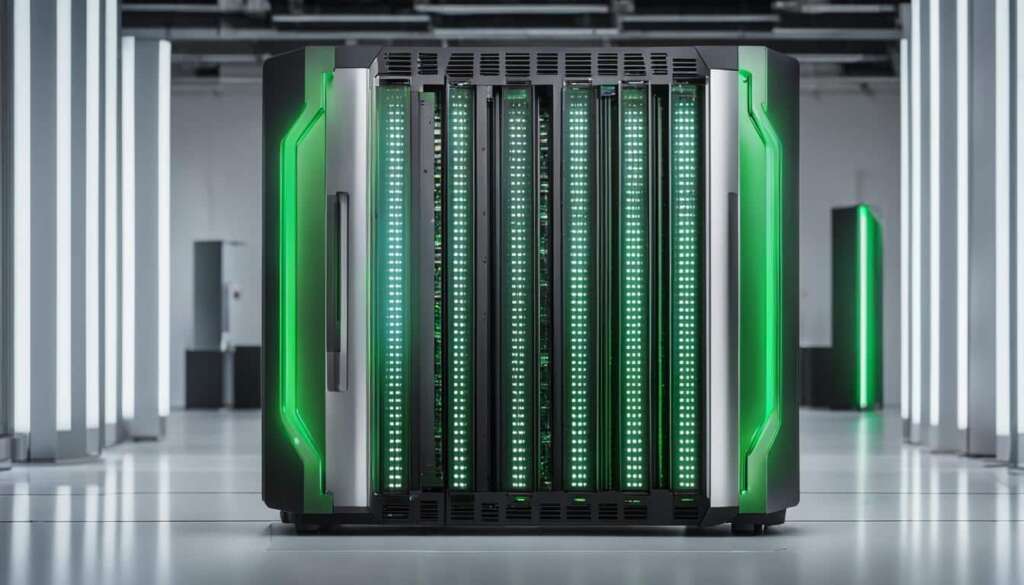Table of Contents
Blade servers have revolutionized data centre technology, providing a more streamlined and efficient approach to managing IT infrastructure. But what exactly is a blade server?
A blade server is a modular server that allows for multiple servers to be housed in a single chassis. Each server, or blade, has its own processors, memory, storage, and networking capabilities. This design allows for easy maintenance and scalability, as additional blades can be added or removed as needed.
Blade servers are an attractive option for businesses seeking to optimize their data centre operations. By understanding the benefits of using blade servers, businesses can make informed decisions when it comes to their IT infrastructure.
Key Takeaways:
- A blade server is a modular server that allows for multiple servers to be housed in a single chassis.
- Each server, or blade, has its own processors, memory, storage, and networking capabilities.
- Blade servers offer easy maintenance and scalability, as additional blades can be added or removed as needed.
- Blade servers can greatly enhance efficiency and streamline your IT infrastructure.
- Implementing blade servers in your data centre can provide cost savings and energy efficiency benefits.
Understanding Blade Servers
Blade servers are a type of server that use a modular design, allowing for multiple servers to be housed in a single chassis. This design saves space, reduces power consumption, and streamlines maintenance by consolidating resources.
Blade server definition: A blade server is a self-contained server module that fits into a chassis, allowing for multiple servers to be housed within a single enclosure.
Blade Architecture
The blade architecture is a key feature of blade servers. Each blade is a self-contained server, with its own processors, memory, storage, and networking capabilities. Blades can be easily inserted and removed from the chassis, allowing for quick and easy installation and maintenance.
“Blade servers offer a high-density solution that allows IT organisations to achieve significant power savings, increased efficiency, and simplified cabling.”
Modular Design
The modular design of blade servers is what makes them so efficient. By having multiple servers in a single chassis, you can reduce the overall space requirements of the data centre, while still providing the necessary power and cooling. This modular design also makes it easy to upgrade individual components, such as processors or memory, without having to replace the entire server.
https://www.youtube.com/watch?v=gDHmsoFtlw4
The image above illustrates the basic blade server architecture, showing how multiple server blades can be housed within a single chassis.
Advantages of Blade Servers
Blade servers offer several advantages when implemented in your IT infrastructure, including:
- Scalability: Blade servers are highly scalable and can easily accommodate future growth as your business expands. With their modular design, you can add or replace blades without disrupting the entire system.
- Cost savings: Blade servers are more cost-effective than traditional rack-mounted servers. They require less cabling, power, and cooling, resulting in reduced operational expenses and lower total cost of ownership.
- Energy efficiency: Blade servers are designed for energy efficiency, with power consumption reduced by up to 80%. This translates to lower energy bills and a smaller carbon footprint for environmentally conscious businesses.
These benefits make blade servers a top choice for businesses seeking to optimize their data centre operations, both in terms of performance and cost-effectiveness.
Conclusion
Blade servers offer a range of benefits for businesses seeking to optimize their IT infrastructure. As we have seen, their modular design and scalability make expansion a breeze, while energy efficiency and cost savings are an added bonus.
Implementing blade servers in your data centre can greatly enhance efficiency, allowing your business to focus on growth and innovation. By understanding the key features and advantages of blade servers, you can make informed decisions when it comes to data centre technology.
As technology continues to evolve, blade servers are likely to remain a key player in the world of data centre technology. By staying up to date with the latest developments and innovations, you can ensure that your business stays ahead of the curve.
FAQ
What is a blade server?
A blade server is a type of data centre technology that is designed to streamline IT infrastructure. It is a highly compact server that consists of multiple individual server modules, or blades, housed in a single chassis. Each blade contains its own processor, memory, storage, and other resources, allowing for efficient resource allocation and easy scalability.
What is the definition of a blade server?
Simply put, a blade server is a modular server system that is made up of multiple self-contained server modules, called blades, which share power, cooling, networking, and other resources within a single chassis. This modular design enables blade servers to be easily installed, managed, and upgraded, simplifying IT infrastructure and reducing costs.
What are the advantages of using blade servers?
Blade servers offer a range of advantages for businesses. Firstly, their modular design allows for easy scalability, enabling businesses to add or remove blades as needed to accommodate changing workloads. Secondly, blade servers can result in cost savings, as they require less physical space, power, and cooling compared to traditional server setups. Lastly, blade servers are known for their energy efficiency, reducing electricity consumption and contributing to a more sustainable IT infrastructure.
How can blade servers benefit a data centre’s IT infrastructure?
Blade servers can significantly enhance a data centre’s IT infrastructure. Their compact form factor allows for higher density, meaning more computing power can be packed into a smaller space. This can help optimize space utilization and reduce data centre footprint. Additionally, blade servers simplify management and maintenance tasks, as multiple blades can be centrally managed within a single chassis. These advantages result in improved efficiency, flexibility, and scalability for data centre operations.













